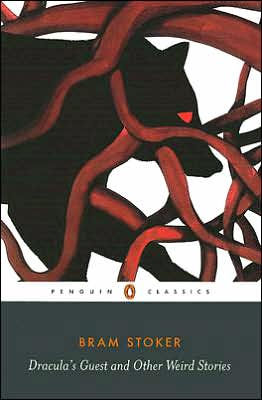Read an Excerpt
Extract from Dracula's Guest and Other Weird Tales by Bram Stoker
Introduction
To many, Bram Stoker’s name has become synonymous with a single piece of work that, since its publication in 1897, has grown to typify the Victorian Gothic genre. Dracula, with its smorgasbord of sexual fantasies and social anxieties, has so far eclipsed anything else that he has written that, to the reader unaccustomed to Stoker’s oeuvre outside it, the extent and range of work that he produced will be somewhat surprising. Thirteen novels, two biographies, one play, one civil service manual and numerous lectures and short stories have all been overshadowed by a single vampire narrative. For a man who wrote so much, that so much should in turn be written about such a small section of his work is a paradox; Dracula remains at the forefront and the focus of both academic and popular interest.
This concept of paradox is actually wholly appropriate to Stoker’s work. Despite Dracula’s longstanding popularity, its literary merits are less assured, Maud Ellmann arguing that ‘the novel wouldn’t be so good if it weren’t so very bad’, whilst of his other works, ‘most of them [were] execrable’. In turn, in his introduction to the 1983 Oxford World Classics edition of Dracula, A. N. Wilson scoffed that, ‘No one in their right mind would think of Stoker as “a great writer”. Popular yet pulp, enduring yet unendurable — the sense of discrepancy inherent in Stoker’s work is also applicable to the author himself; the volume of literature that has been produced about Stoker since the revival of his reputation in the early 1970s testifying, ironically, to his indecipherability. Since 1962 four full-length biographies have been written which, whilst illuminating the facts about Stoker’s life, nevertheless fail to get to grips with the man himself. There is very little material extant in which Stoker bares his innermost thoughts. As enigmatic as his most renowned creation, Stoker himself confessed in a letter to Walt Whitman in 1872 that, ‘I…;am naturally secretive to the world’.
The bare facts about Stoker’s life have provided rich pickings for literary detective work, and critics have tended to read his works as much for the potential biographical insight they can offer as for the stories they tell. The most manifestly persistent of these critical interpretations has been speculation about his sexual proclivities. Claims have been equally stringently made for Stoker’s rampant heterosexual carnality, his closet homosexuality, his anal fixations, oral fixations, Oedipus complex, fear of assertive women (especially mothers) and domination fetishes. The most enduring mystery surrounding Bram Stoker’s life in this respect has been his death. Locomotor Ataxia, a stated cause of death on Stoker’s Death Certificate, was hailed as proof of the author’s contraction of syphilis and thus womanizing reputation by Daniel Farson. Whilst this was rejected by Stoker’s third biographer, Barbara Belford, and similarly dismissed by Haining and Tremayne as ‘unproven’. Stoker’s most recent biographer, Paul Murray, has once more taken up the argument for his ‘likely’ syphilitic condition, citing the author’s stroke in 1906, his prescription for arsenic medication in 1910 and his stamping way of walking as evidence.
The virtual impenetrability of Stoker himself and the excesses contained within his fiction lend themselves to this outpouring of biographical conjecture. William Hughes and Andrew Smith argue that Dracula has become ‘the Freudian text par excellence’, revealing a wide range of repressed sexual desires and concerns. Among other interpretations, the syphilitic condition here too has been raised, the novel’s preoccupation with insanity, pestilence and implicitly sexual contamination being cited as evidence of Stoker’s own sexual ill-health.
To read novels solely for a glimpse of their biographical signposts, however, is to do both text and author a great disservice. Whilst fascinating in their own right as the last published works of Bram Stoker, the two hooks that comprise this volume, Dracula’s Guest and Other Weird Stories and The Lair of the White Worm also demonstrate that ultimately Stoker was a master of the Gothic genre, fully justifying his reputation alongside late-nineteenth-century greats’ such as Robert Louis Stevenson, H. G. Wells, Sheridan Le Fanu, Oscar Wilde and Arthur Conan Doyle.
Aside from the spine-chilling excellence of such stories as ‘The Burial of the Rats’, ‘The Squaw’ and ‘The Judge’s House’, Stoker offset his tales of the weird and uncanny with an experimental outlook that not only responded to the social conscience of the late nineteenth and early twentieth centuries, but also tapped into contemporaneous experimental movements in art and literature. Far from the rather slapdash image that Stoker’s fiction beyond Dracula has generated, such works can be seen to be the product of deep thought, research and a profound understanding of the society in which he lived. The Lair of the White Worm, for example, widely dismissed as ‘clearly the work of a man sick in mind if not in body’, is, in reality, an intensely intriguing novel, working on mythic, historical, social and sexual levels, whilst also responding to nineteenth- and early twentieth-century shifts in artistic expression. In short, Stoker was a popular fiction writer of significant aptitude, in tune with the undercurrents of the social thought and creative articulation of his time.
(Continues…)
Excerpted from "Dracula's Guest and Other Weird Tales"
by .
Copyright © 2007 Bram Stoker.
Excerpted by permission of Penguin Publishing Group.
All rights reserved. No part of this excerpt may be reproduced or reprinted without permission in writing from the publisher.
Excerpts are provided by Dial-A-Book Inc. solely for the personal use of visitors to this web site.




